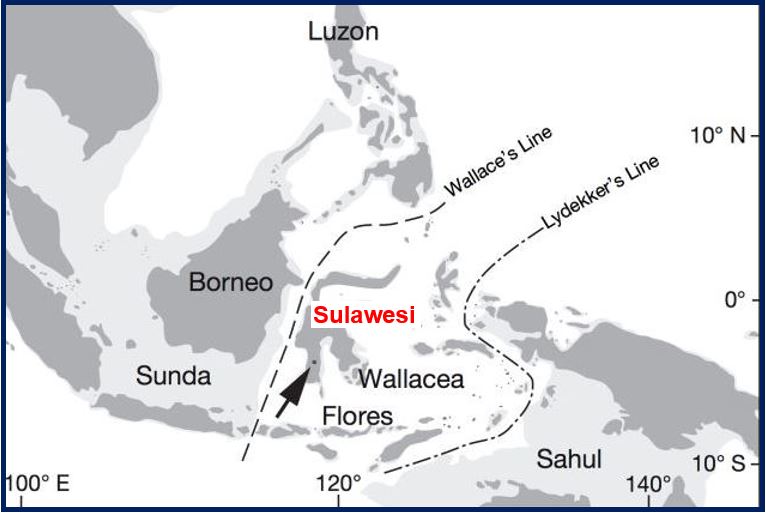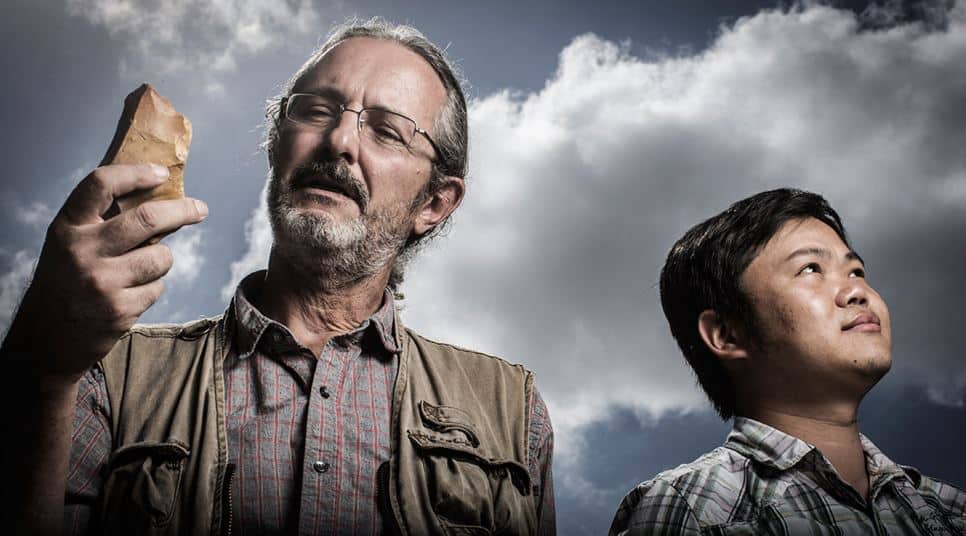The mysterious Hobbit humans who likely lived in the Indonesian island of Sulawesi were there over 100,000 years ago, which was 60,000 years earlier than experts had previously estimated, says an international team of scientists that discovered new archaeological evidence.
Paleoanthropologists (they study of the origins of human species using fossils and other remains) have long believed that humans first entered Sulawesi between 40,000 and 60,000 years ago. The island may have been the stepping stone for the first humans to arrive in Australia between 50,000 and 60,000 years ago.
A research team, led by the University of Wollongong (UOW), New South Wales, Australia, including scientists from other centres in Australia as well as Indonesia and Denmark, reported in the academic journal Nature that stone artefacts dated more than 100,000 years on Sulawesi were discovered. They used the state-of-the-art luminescence dating technique for feldspar minerals.
 These stone artefacts were found lying scattered on the gravelly surface near Talepu. (Image: uow.edu.au)
These stone artefacts were found lying scattered on the gravelly surface near Talepu. (Image: uow.edu.au)
Study leader Dr. Gerrit van den Bergh, who works at UOW’s Centre for Archaeological Science (CAS) and colleagues excavated Talepu, an open-air site in the south-western arm of Sulawesi, and discovered stone tools alongside the fossil remains of the extinct and extant megafauna. The archaeologists dug 12 metres into the ground.
Pre-modern hominins likely were on Sulawesi before modern humans
Dr. van den Bergh said:
“It now seems that before modern humans entered the island, there might have been pre-modern hominins on Sulawesi at a much earlier stage.”
The authors believe that it is possible that – like Flores, the island where the ‘Hobbit’ (Homo floresiensis) fossils were unearthed over ten years ago – fossils of pre-modern humans may yet be discovered on Sulawesi.
“Sulawesi, like Flores, could have been a natural laboratory for human evolution under isolated conditions,” Dr van den Bergh explained.
 Wallacea has two major biogeographical boundaries: Lydekker’s Line to the east and Wallace’s Line to the west. Exposed land during periods of low sea level (−120 metres) is lightly shaded. The arrow points to the Talepu Area. (Image: nature.com)
Wallacea has two major biogeographical boundaries: Lydekker’s Line to the east and Wallace’s Line to the west. Exposed land during periods of low sea level (−120 metres) is lightly shaded. The arrow points to the Talepu Area. (Image: nature.com)
Talepu site discovered in 2007
The Talepu excavation site was discovered in 2007 by Dr. van den Bergh while he was surveying the area with Mr. Anwar Akib, who works at the local Cultural Heritage Department.
The survey formed part of a collaboration led by the late Professor Mike Morwodd that discovered the ‘Hobbit’. Dr. van den Bergh was working as a Research Associate at the time.
Dr. van Bergh said that a new road had been cut at Talepu. It passed through gravel deposits, exposing several stone artefacts on the surface. How old the artefacts were was unclear, and early attempts to date the deposits were inconclusive.
In October 2012, a new luminescence dating technique for feldspars – multiple elevated temperature post-infrared stimulated luminescence (MET-pIRIR) – was used to date the Talepu deposits.
 Dr van den Bergh holding a stone artefact, with co-author Dr Bo Li. (Image: uow.edu.au)
Dr van den Bergh holding a stone artefact, with co-author Dr Bo Li. (Image: uow.edu.au)
Stone tools more than 100,000 years old
The dating results provided a major breakthrough, showing that the stone tools that had been unearthed were over 100,000 years old. These estimated datings were supported by another dating technique that was carried out on the fossil teeth – naturally occurring uranium absorbed by the teeth after burial was measured.
Scientists say they are uncertain what species of human made the stone tools.
 Homo floresiensis (Hobbit) is widely believed to be an extinct species in the genus Homo. The remains of one individual that would have stood about 3.5 feet (1.1 m) in height were discovered in 2003 on the island of Flores, Indonesia. (Image: arc-team)
Homo floresiensis (Hobbit) is widely believed to be an extinct species in the genus Homo. The remains of one individual that would have stood about 3.5 feet (1.1 m) in height were discovered in 2003 on the island of Flores, Indonesia. (Image: arc-team)
The old ages suggest that whoever made the tools were either an archaic lineage of humans or some of the earliest modern humans who made their way to Southeast Asia, and possibly were the ancestors of the first people to arrive in Australia. The authors believe the second possibility is the most likely.
In an Abstract in the journal, the authors concluded:
“Our findings suggest that Sulawesi, like Flores, was host to a long-established population of archaic hominins, the ancestral origins and taxonomic status of which remain elusive.”
The study was supported by the Geological Agency of Indonesia and ARC (Australia Research Council) grants.
Citation: “Earliest hominin occupation of Sulawesi, Indonesia,” Gerrit D. van den Bergh, Bo Li, Adam Brumm, Rainer Grün, Dida Yurnaldi, Mark W. Moore, Iwan Kurniawan, Ruly Setiawan, Fachroel Aziz, Richard G. Roberts, Suyono, Michael Storey, Erick Setiabudi & Michael J. Morwood. Nature 529, 208–211. Published 14 January 2015. DOI:10.1038/nature16448.
Video – Homo floresiensis, the little people of Flores
